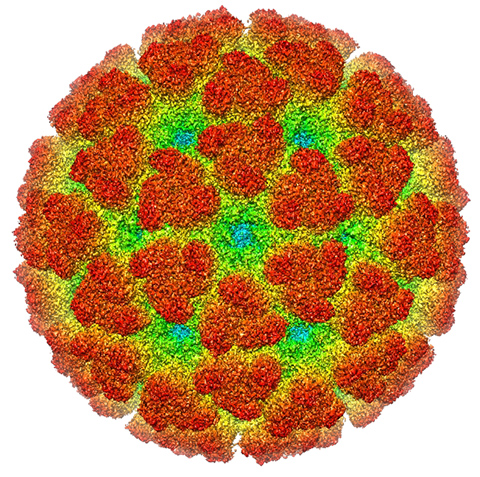From the journals: JBC
Cap-snatching viruses. Membrane makeup facilitates fusion. A disordered region promotes scaffold activity. Read about papers on these topics recently published in the Journal of Biological Chemistry.
Cap-snatching viruses
Alphaviruses like the chikungunya virus, or CHIKV, are positive single-stranded RNA viruses that use a unique mRNA capping machinery distinct from that of host cells, which makes a great candidate for antiviral drugs. The N7-methylguanosine RNA cap can recruit cellular proteins to initiate translation, and its removal or “decapping” can lead to exoribonuclease-mediated degradation; as such, many viruses have evolved strategies to cap their own mRNAs, or even to decap host RNAs to create decoy noise and mask their own RNA production.
Recent cryo-electron microscopy structures of the CHIKV capping enzyme nsP1 indicated that the methyl group is first stolen from a host RNA and added to nsP1, and then transferred using nsP1’s guanylyltransferase activity to the viral RNA. In their new study published in the Journal of Biological Chemistry, Michelle Cheok Yien Law and colleagues at Nanyang Technological University in Singapore explored this process using cryo-EM structures of their own with nsP1 bound to RNA substrates. They showed that not only can nsP1 remove the N7-methylguanosine cap from both host and viral RNAs, but that this decapping can trigger the host interferon immune response. Using an RNA structure that mimics the native host cap, they used cell-based assays to demonstrate that nsP1 decapping activity activates RIG-I-mediated type I interferon signaling.
The authors theorize that CHIKV nsP1 may selectively decap certain mRNAs to prevent translation overload and alerting cells in the early stages of infection. It is also possible that the ratio of capped to decapped RNAs can impart some kind of signal crucial for viral replication or immune escape. Future work will be necessary to determine the roles of RNA decapping in relevant biological systems, as well as the roles of interaction of nsP1 with other viral and host proteins.
Membrane makeup facilitates fusion
Lipid membranes are composed of saturated and unsaturated lipid molecules of varying polar and apolar classes, all of which inform structural properties, such as viscosity and rigidity, that can affect membrane fusion. Why then can membranes with different lipid ratios and compositions have similar mechanical properties? In a recent paper in the Journal of Biological Chemistry, Rafael Lira and colleagues at Zernike Institute in Groningen, Netherlands, used confocal microscopy, time-resolved imaging and electroporation to examine the underlying properties of lipid membranes that regulate membrane fusion.
They found that fusogenic potential is greater in the inner leaflets of bipolar membranes, which typically have more unsaturated lipids and are less ordered (and thus, more fluid), as well as having more negatively charged lipid species. In addition, they showed that cholesterol, a key lipid in biological membranes, plays a huge role in membrane stiffness and stability, mildly reducing fusion efficiency but buffering membranes against disruptions such as pore formation. The authors concluded that membrane fluidity is a main determinant of fusion, and increased membrane viscosity impairs fusion.
These findings help to illuminate the mechanical properties that promote membrane dynamics, which are critical in biological processes such as cellular signaling, migration and repair, and also provide evidence that cells can tune their fusion properties by altering membrane composition in numerous ways.
A disordered region promotes scaffold activity
Scaffold proteins are so named because they act as docking hubs for interacting proteins, but they can also play more active roles in cell signaling by undergoing conformational changes to promote signaling events. For example, the scaffold protein NEMO, which is essential in canonical signaling of the nuclear transcription activator NF-κB, becomes more compact when binding the NF-κB upstream activator IKKβ and can undergo liquid–liquid phase separation upon binding ubiquitin.
In a recent article in the Journal of Biological Chemistry, Christopher DiRusso, Anthony DeMaria and colleagues at Boston University found that the intervening domain, or IVD, in the central region of NEMO is necessary for activation of IKK, and that mutation of the IVD inhibits liquid–liquid phase separation. Using thermal and chemical denaturation assays, the authors showed that the IVD puts conformational strain on the surrounding protein regions and reduces their stability, promoting disorder and phase separation and thus mediating allosteric communication between the N-terminal and C-terminal NEMO domains.
These results support a model of NEMO activity in which an ordered domain promotes disorder and phase separation by mediating conformational changes. Mutations in this region that affect stimulus-induced conformational change could represent a new type of pathogenic scaffold mutation.
Enjoy reading ASBMB Today?
Become a member to receive the print edition four times a year and the digital edition monthly.
Learn moreGet the latest from ASBMB Today
Enter your email address, and we’ll send you a weekly email with recent articles, interviews and more.
Latest in Science
Science highlights or most popular articles

The science of staying strong
Muscles power every movement, but they also tell the story of aging itself. Scientists are uncovering how strength fades, why some species resist it and what lifestyle and molecular clues could help preserve muscle health for life.

Bacteriophage protein could make queso fresco safer
Researchers characterized the structure and function of PlyP100, a bacteriophage protein that shows promise as a food-safe antimicrobial for preventing Listeria monocytogenes growth in fresh cheeses.

Building the blueprint to block HIV
Wesley Sundquist will present his work on the HIV capsid and revolutionary drug, Lenacapavir, at the ASBMB Annual Meeting, March 7–10, in Maryland.

Gut microbes hijack cancer pathway in high-fat diets
Researchers at the Feinstein Institutes for Medical Research found that a high-fat diet increases ammonia-producing bacteria in the gut microbiome of mice, which in turn disrupts TGF-β signaling and promotes colorectal cancer.

Mapping fentanyl’s cellular footprint
Using a new imaging method, researchers at State University of New York at Buffalo traced fentanyl’s effects inside brain immune cells, revealing how the drug alters lipid droplets, pointing to new paths for addiction diagnostics.

Designing life’s building blocks with AI
Tanja Kortemme, a professor at the University of California, San Francisco, will discuss her research using computational biology to engineer proteins at the 2026 ASBMB Annual Meeting.


